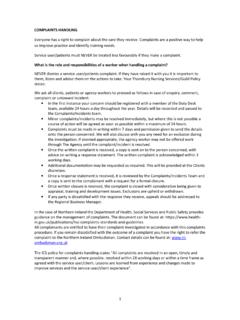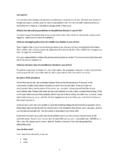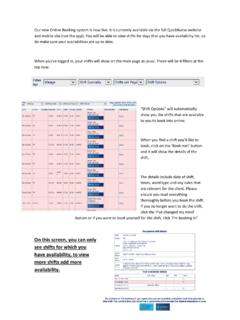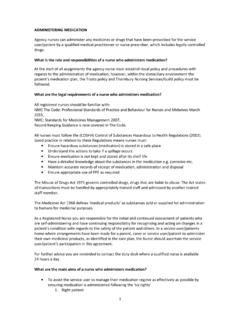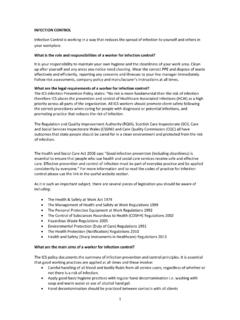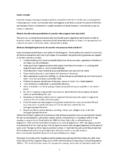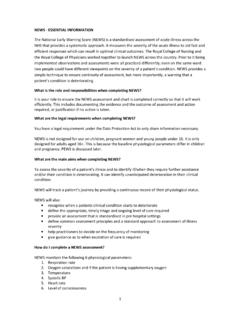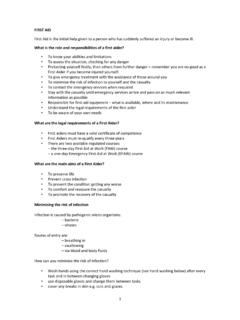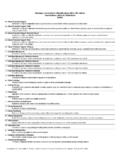Transcription of CONFLICT RESOLUTION HSE (Health and Safety …
1 1 CONFLICT RESOLUTION HSE ( health and Safety executive ) definition of violence at work:- Any incident where an employee is abused, threatened or assaulted in circumstances relating to their work . This includes physical attack whether visible injury occurs or not, including sexual or racial attack. Serious verbal abuse and threatening behaviour; an unacceptable threat has been made against a person including via the phone, electronically, social media and in person by a third party . What is the role and responsibilities of a worker in relation to managing violence and aggression? You must ensure your own Safety at all times. Follow the risk assessments laid down in the individuals care plan, ensuring they are updated when necessary and appropriate.
2 You must stay calm and use techniques to diffuse the situation and calm the other person down. What are the legal requirements of a worker in relation to managing violence and aggression? Employers have a legal duty to ensure the health , Safety and welfare of their employees under the health and Safety at Work Act 1974. In addition, the Management of health and Safety at Work Regulations 1999 place specific requirements on employers to assess the risks to their employees, and to take appropriate measures to prevent or reduce the risks. These legal duties include protecting employees from exposure to reasonably foreseeable violence at work, both physical and verbal abuse.
3 What are the main aims of a worker in relation to managing violence and aggression? Allow time for a person to process and understand Allow for time to respond Be aware of body language Use short understandable sentences Think about the individuals needs The ICS policy violence and Aggression in the workplace states: ICS values its workers and will take reasonable steps to secure the health and Safety of workers who may be exposed to the risk of aggression, violence or abuse in the work place . ICS will not tolerate violent, aggressive, antisocial behaviour towards workers during the course of their duties. ICS will take action against offenders where there is no medical condition, or where the act is deliberate, which may result in withdrawal of treatment or care.
4 ICS acknowledge that some service users may display challenging behaviour which manifests in violence and aggression and will work alongside statutory services to manage such situations . 2 definition of violence at work The British Crime Survey (BCS) measures respondents experiences of crime related incidents and classifies these into offence types (including physical assaults and threats), and also collects detailed information about the nature of the victimisation. Physical assaults include assault with minor injury, assault without injury, wounding and robbery; threats include verbal threats made to or against the recipient. Some addendums have been made to some definitions, to include electronic bullying and harassment via social networking sites and emails.
5 Section 2(2)*c* The health And Safety at Work Act The Employer has a responsibility to ensure that employees receive such information, instruction, training and supervision, as is necessary, to ensure the health , Safety and welfare of staff by ensuring staff competence. Employment Rights Act, Section 44 Prevents an employer from taking action such as dismissing or disciplining an employee who leaves their place of work because of danger, which they believe to be serious and imminent and which they could not be reasonably expected to prevent. This includes taking any appropriate steps to protect themselves or others from the danger. Legal framework A person can face both a criminal and civil prosecution.
6 It is not necessary that a criminal conviction is secured for a successful civil action to take place. Assault Assault is an act by any person/s that makes another fear the application of immediate personal violence /harm. It is not necessary that touch or actual harm takes place, nor is intention important. This could be eye contact, perceived physically aggressive gesturing or the use of verbal threats. The ICS policy Managing Challenging Behaviour states: The term challenging behaviour has been used to refer to the difficult or problem behaviour, which may be shown by adults or children with learning disabilities . Challenging behaviour is not limited to service users with learning disabilities.
7 Service users with acquired brain injuries and other conditions can also have challenging behaviour . Challenging behaviour puts the Safety of the service users or others (ICS workers) in some jeopardy or has significant impact on the service users and other people s quality of life . ICS acknowledges that some clients may display challenging behaviour with violence and aggression and will work alongside statutory services to manage such situations . 3 ICS understands the importance of appropriate training for ICS workers managing challenging behaviour especially when physical intervention is required . Challenging behaviour- Communication The most important form of intervention is the lowest level effective communication, active listening skills and diffusion strategies.
8 We as health care staff who potentially face CONFLICT should not embrace a culture of physical intervention as a primary strategy. Tips for effective communication: Explore the reasons for the persons emotional arousal Identify possible positive outcomes Can you assist with the removal of the trigger? Would environmental change help? Validate the persons feelings Use active verbal/non-verbal approaches Appropriate proxemics (personal space awareness) Non-threatening attendance. Verbal communication is made up of spoken word, phrases and content and equate to around 7% of the total message. Vocal communication is made up of tone, volume, pitch and intonation and in heated dialogues ( CONFLICT ) makes up around 38% of the overall message.
9 Non-verbal communication has been proven to be the most influential form of resolve when dealing with challenging situations, this makes up around 55% of the conversation. (Mehrabian s communication model) Windows of the soul Our eyes will be very expressive during conversations and give off messages sometimes without our awareness Joy Happiness Sadness Fear Anger Facial Expressions Our eyes and mouth are powerful communicators, our facial expressions when dealing with an angry person can alternate as quickly as our thoughts. Duty of Care linked to personal Safety : The Manchester NHS and Social Care Trust state in their 2007 service governance directorate entitled The prevention and management of violence and aggression at work against NHS staff policy : 4 Every employee has a duty of care to ensure the Safety of themselves and others during an incident of violence .
10 Employees will co-operate with the measures provided for their Safety both in terms of the risk assessment process, the development and implementation of control arrangements. Employees should attempt to minimise a potentially violent situation by withdrawing from the situation if the opportunity arises. Employees should attempt to minimise a potentially violent situation by responding appropriately as a member of the MVA (Restrictive Physical intervention) team or withdraw. Duty of care We have a duty of care to those around us, we should always endeavour to ensure that we identify risks and inform others of the risks and danger. We should also where possible try and prevent harm coming to those around us, but this should not be at the cost of our own Safety .
